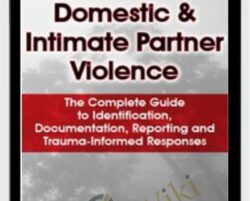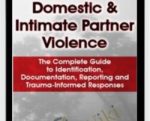All clinicians are likely to encounter Domestic and Intimate Partner Violence at some point in their practice. And if you fail to recognize the abuse and properly respond, the consequences can be dire.But abuse can be difficult to detect when the physical signs of violence fade. And now more than ever, you’re conducting video sessions, giving you a unique glimpse into clients homes and potential abuse. It’s a complicated situation that can leave you caught between confidentiality, autonomy, and your wider responsibilities to protect victims.What clinical decisions should you make to balance supporting your client while adhering to your licensure requirements?Katelyn Baxter-Musser, LCSW has provided behavioral health counseling, crisis intervention and support to families and individuals facing domestic violence and abuse for over a decade.Watch her in this one-day training that will serve as an indispensable guide for improving outcomes for those impacted by domestic and intimate partner violence. Not only will she answer your most pressing questions, you’ll walk away with:Screening tools to assess for safety, risk and lethalityChecklists and advocacy resourcesDocumentation and confidentiality strategiesGuidance on crisis intervention and safety planningCulturally competent responses to abuseTrauma-informed interventions for clients exposed to domestic violenceTips for handling complex domestic violence situations created by COVID-19 and video sessionsPlus, Katelyn will share 3 powerful techniques to help you manage the burnout and compassion fatigue that can weigh you down when working with these emotionally draining cases!Whether you’re a social worker, counselor, psychologist, marriage and family therapist, nurse, or anyone in the helping professions, this is one program you can’t afford to miss.Purchase today!Employ screening techniques to identify the signs of domestic violence (DV) and intimate partner violence (IPV) in clients. Investigate how evidence-based screenings and assessments can help clinicians determine level of risk and lethality so they can intervene in crisis situations. Analyze ways in which clinicians can ensure proper reporting and documentation when working with clients facing violence in their relationships or homes. Evaluate the types of domestic abuse including physical violence, sexual violence, threats and intimidation. Justify how an understanding of cultural factors can help clinicians to ensure a competent response to abuse. Develop safety plans with clients to help them leave an abusive or violent home. Utilize trauma-informed treatment techniques for survivors of abuse, violence and oppression. Get Domestic & Intimate Partner Violence: The Complete Guide to Identification, Documentation, Reporting and Trauma-Informed Responses – Katelyn Baxter-Musser, Only Price $87Domestic and Intimate Partner Violence 101Myths about domestic and intimate partner violenceDefining Abuse: Types of domestic violenceWho is at risk?Warning signs and symptomsSubstance abuse and domestic violenceAbuse in the LGBTQ CommunityCOVID-19 and impact on DV/IPVRecognize the Red Flags of Violence: What All Clinicians Need to KnowScreening and assessment techniquesIdentify immediate dangerTools to assess for safety, risk and lethalityChecklists and advocacy resourcesTechnology and domestic/intimate partner violenceReporting Requirements and Documentation GuidelinesPrivacy and confidentialityWho is required to report and when?Standards for making a reportDomestic violence hotlinesProper documentation and confidentiality strategiesThe Next Steps: Crisis Intervention & Safety PlanningBarriers to leavingSafety plans while living with abusive partnersSafety planning for childrenEmotional safety planningPlans for leaving and after leavingRestraining orders/protective ordersCulturally Competent Responses to AbuseRecognizing your own biasesHow survivors interpret domestic violence in their cultureAdapting danger assessments for underserved populationsWhat is victim-blaming and how to avoid itTrauma-Informed Interventions: Transition Clients from Surviving to ThrivingAssess for PTSD, anxiety, trauma and other mental health issuesUnderstand the multilayered impact of DV/IPVProcessing shame, anger and guiltWorking with children exposed to domestic violenceResearch, limitations and treatment risksVicarious Trauma & The ClinicianWhat is compassion fatigueRecognizing signs of burnoutSelf-care techniques for the professionalGet Domestic & Intimate Partner Violence: The Complete Guide to Identification, Documentation, Reporting and Trauma-Informed Responses – Katelyn Baxter-Musser, Only Price $87Tag: Domestic & Intimate Partner Violence: The Complete Guide to Identification, Documentation, Reporting and Trauma-Informed Responses Review. Domestic & Intimate Partner Violence: The Complete Guide to Identification, Documentation, Reporting and Trauma-Informed Responses download. Domestic & Intimate Partner Violence: The Complete Guide to Identification, Documentation, Reporting and Trauma-Informed Responses discount.
 Somatic Interventions in Couples Therapy – Deborah J Fox
₹3,818.00
Somatic Interventions in Couples Therapy – Deborah J Fox
₹3,818.00
 Sex, Couples and the Integration of Somatic Interventions – The Path to Safety, Connection and Resolution – Deborah J Fox
₹13,778.00
Sex, Couples and the Integration of Somatic Interventions – The Path to Safety, Connection and Resolution – Deborah J Fox
₹13,778.00
Domestic & Intimate Partner Violence: The Complete Guide to Identification, Documentation, Reporting and Trauma-Informed Responses
₹13,778.00






